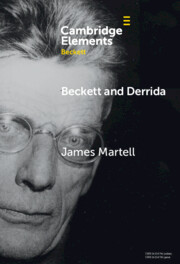Element contents
Beckett and Derrida
Published online by Cambridge University Press: 27 November 2024
Summary
- Type
- Element
- Information
- Series: Elements in Beckett StudiesOnline ISBN: 9781009414364Publisher: Cambridge University PressPrint publication: 19 December 2024
Bibliography
- 1
- Cited by

